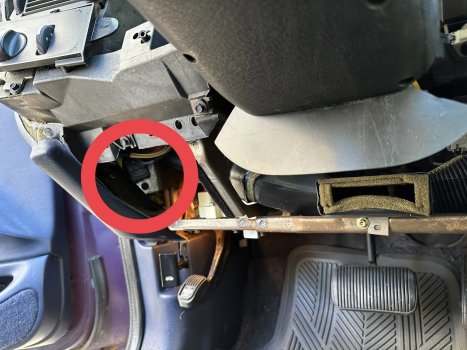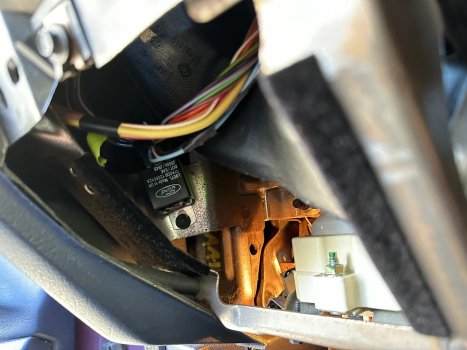CDsDontBurn
PostWhore
tamper proof clamp
but I personally just hack them off
So you admit to tampering with them?
tamper proof clamp
but I personally just hack them off
This is gonna be a really stupid question, but, can the inner tie rods be replaced? I can't find the procedure in the Haynes manual. without looking into it I purchased both inner and out tie rods when I was on Rockauto because they were super affordable and it would only increase shipping by $1.86 so I figured hey why not, my steering is pretty loose and it needs to be done. But its not obvious if it is replaceable. I know I need the special tool but I can rent that for free from Part Source.

I got mevotech ones and they seem to be quite good, they have the pins as well but I still plan to use locktite so there is no chance I lose my steering.I found that some of the aftermarket inner tierod ends have a dowel pin that gets tapped in after install. Some like the OE Motorcraft don't have it, so Loctite is probably a good idea on them.
Here is one that has it, guess some have two.
View attachment 12002
Also TRW inner tire rods are on clearance at RA for $9.16... Good price for the OEM part, I recently paid 30 something for a Motorcraft
I cant say for sure but my initial thought is that its probably not great to have acidic fluid running through the system (not a criticism just an observation) of course windshield washer fluid is mostly alcohol which is very slightly acidic, but vinegar despite being a weak acid is more corrosive than alcohol. Although to say it caused the leak would be a fallacy as there are too many variables (age, condition, etc.) to pin it on that alone. but it might have contributedWill vinegar eat away at the windshield sprayer plumbing? Asking about the hard lines, I had a couple leaks and we use some home made washer fluid that’s a mix of vinegar soap and water.
I would recommend if its in the budget to just use regular windshield washer fluid, every vehicle I have ever come across that has used exclusively it has never had a problem, even going between hot summers and super cold winters, although full time hot weather and sun is probably harder on it than our conditions but still, I also think washer fluid maybe has some properties that help condition seals and rubber and corrosion inhibitors for hardline so fwiw I would use it once you seal the leaksThe contribution is my concern as well. It is 29 years old, she’s been in the NC sun for ~ the last 6 of those years, so probably not a single root cause.
Will vinegar eat away at the windshield sprayer plumbing? Asking about the hard lines, I had a couple leaks and we use some home made washer fluid that’s a mix of vinegar soap and water.
Good to know, thank you!It just unscrews out of the rack. Just get a big pair of channel locks or vice grip or adjustable wrench and it spins right off, then the new one spins back on.
I got a corded power sweep toro leafblower for cheap at an estate sale. How bad of an idea is it to use it on the engine bay?
Do yall think an amber bulb in the rear turn signal would look bad? I wanna get an led upgrade and the only one I know that will not hypeblink is an amber one
oh, ok, couple questions then, what relay would I need and where in the car is it?It would still look red-ish, but not be as bright. Tried it.
Simply replace your flasher relay with an LED-friendly unit. They're inexpensive. Problem solved.
oh, ok, couple questions then, what relay would I need and where in the car is it?




I replaced both the tank and the sensor as they were falling apart. I went to the junk yard and found both in good condition. As for the sensor, there is no gasket. I tried that and it did not help. You can get the return line from the tank to the radiator at the parts store. I would suggest simple clamps on both ends of the return line, but not necessary with the right tubing. The last person may have replaced the tubing with one that is not the right size. This cooling system is supposed to be a closed system and should not leak. If it does, track it down and fix it.Another leak, looks like possibly from the level sensor in the coolant overflow tank. Very slight as the level is still correct, but moisture going down under the battery and on there front bumper cover.
I’d there a gasket I can replace on that sensor?
Like my Town Car, the V8 uses a screw on pressure cap at the reservoir. The V6 is not pressurized, but is a closed system. Meaning, and correct me if if I am wrong, but when the engine is hot, the expanding fluid goes to the reservoir, and when it cools, it goes back to the radiator. Hence, no fluid is lost. There is some evaporation after time due to weather conditions, but otherwise, you should not have have any fluid loss. For example, if you have a head gasket leak, the fluid is being burned off through the leaking head / cylinder, so the reservoir will lose fluid. Otherwise, no leaks, no loss.@White Lincoln
I think the car referenced was a V8 though (?).
Someone correct me if I'm wrong, but I think the V8s all have a fully pressurized coolant system, meaning the tank itself is also pressurized.
On the V6s, there's a pressure release cap on top of the radiator which allows coolant to go into the overflow tank.
A pressure cap on the radiator, to my knowledge is used to release the pressure when the car is overheating or if you need to work on the cooling system
when the engine is hot, the expanding fluid goes to the reservoir
you uncap the radiator cap slowly to release the pressure
